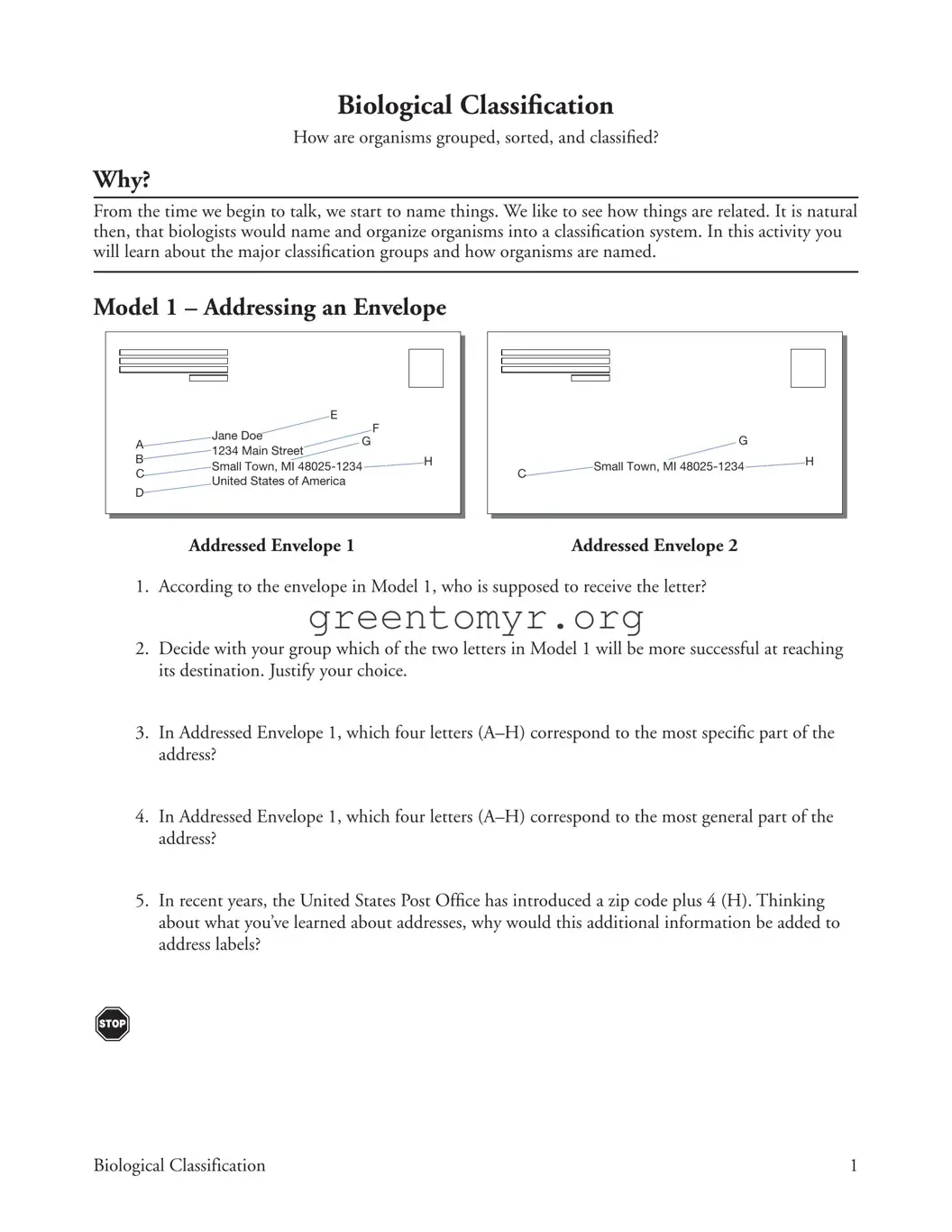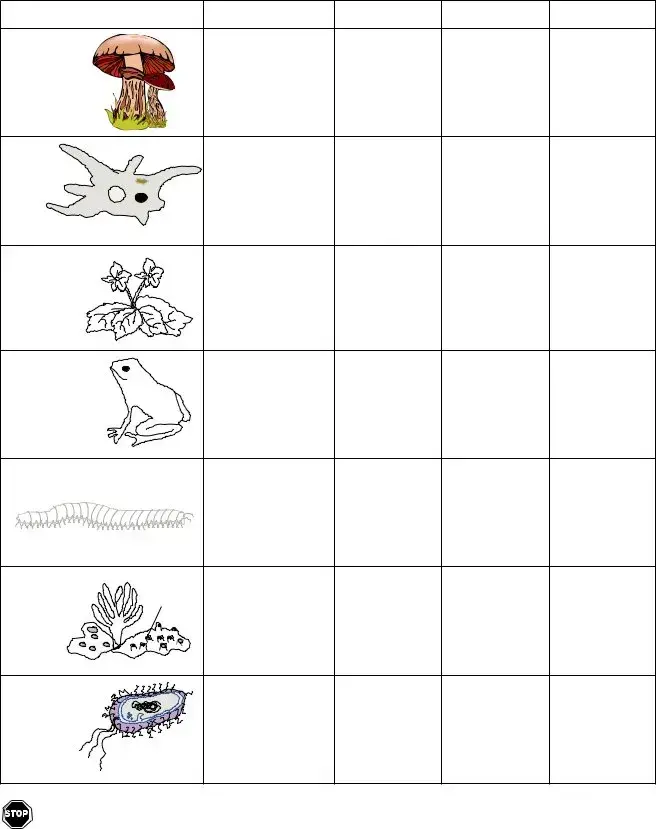Biological Classification
How are organisms grouped, sorted, and classiÞed?
Why?
From the time we begin to talk, we start to name things. We like to see how things are related. It is natural then, that biologists would name and organize organisms into a classiÞcation system. In this activity you will learn about the major classiÞcation groups and how organisms are named.
Model 1 – Addressing an Envelope
|
|
|
|
|
|
E |
|
|
|
|
|
|
|
|
|
|
|
|
|
|
|
|
|
|
|
|
|
|
JANE DOE |
|
F |
|
|
A |
|
G |
|
|
|
|
|
|
|
|
1234 MAIN STREET |
|
|
|
|
|
|
|
|
|
|
|
|
|
|
|
|
B |
|
|
|
|
|
|
|
|
|
|
SMALL TOWN, MI 48025-1234 |
|
|
H |
|
|
C |
|
|
|
|
|
|
|
|
|
UNITED STATES OF AMERICA |
|
|
|
|
|
|
|
|
|
|
|
|
|
|
|
|
|
|
D |
|
|
|
|
|
|
|
|
|
|
|
|
|
|
|
|
|
|
|
|
|
|
|
G
SMALL TOWN, MI 48025-1234  H
H
Addressed Envelope 1 |
Addressed Envelope 2 |
1.According to the envelope in Model 1, who is supposed to receive the letter?
2.Decide with your group which of the two letters in Model 1 will be more successful at reaching its destination. Justify your choice.
3.In Addressed Envelope 1, which four letters (AÐH) correspond to the most speciÞc part of the address?
4.In Addressed Envelope 1, which four letters (AÐH) correspond to the most general part of the address?
5.In recent years, the United States Post OfÞce has introduced a zip code plus 4 (H). Thinking about what youÕve learned about addresses, why would this additional information be added to address labels?
Biological Classification |
1 |

Model 2 – Taxonomy
|
Envelope |
|
Taxa |
Lion |
Tiger |
House Cat |
|
(Jane Doe) |
|
(Panthera leo) |
(Panthera tigris) |
(Felis catus) |
|
|
|
|
|
|
|
|
|
|
Country |
|
|
Kingdom |
Animalia |
Animalia |
Animalia |
|
|
|
|
|
|
|
State and Zip |
|
|
|
Chordata |
Chordata |
Chordata |
|
|
|
|
|
|
|
Town |
|
|
|
Mammalia |
Mammalia |
Mammalia |
|
|
|
|
|
|
|
Street name |
|
|
|
Carnivora |
Carnivora |
Carnivora |
|
|
|
|
|
|
|
House No. |
|
|
|
Felidae |
Felidae |
Felidae |
|
|
|
|
|
|
|
Last name |
|
|
|
Panthera* |
Panthera |
Felis |
|
|
|
|
|
|
|
First name |
|
|
|
leo |
tigris |
catus |
|
|
|
|
|
|
|
|
|
|
|
|
|
|
6.Using the envelope outline from Model 1, classify the full address by writing the appropriate information in the ÒEnvelopeÓ column in Model 2.
Read This!
Carolus Linneaus (1707Ð1778) is known as the father of modern taxonomy. Taxonomy is the science of Þnding, describing, and categorizing organisms with the ultimate goal to name the species. In traditional Linnean taxonomy the seven major taxonomic groups are (in order from least speciÞc to most speciÞc)
Kingdom, Phylum, Class, Order, Family, Genus, and Species. Modern taxonomy categorizes the six kingdoms into three domains.
7. Use the Linnaean taxonomic groupings to complete the third column of the table above.
8.Which two of the three cats listed in Model 2 are most closely related? Explain your answer.
9.At which taxonomic level do the two cats you identiÞed in Question 8 separate?
10.What is the most speciÞc taxonomic grouping in which all three cats are the same?
11.What is different about the way the genus and species names are written compared to the other taxa?
2 |
POGILª Activities for High School Biology |

 12. The genus and species names are collectively referred to as the scientiÞc name. It is written in a form known as binomial nomenclature, a two-term Latin naming system. There are three rules for writing a scientiÞc name using this system. Analyze the information in Model 2 to complete the rules below:
12. The genus and species names are collectively referred to as the scientiÞc name. It is written in a form known as binomial nomenclature, a two-term Latin naming system. There are three rules for writing a scientiÞc name using this system. Analyze the information in Model 2 to complete the rules below:
Rule 1: The scientiÞc name is always written in ____ parts, with the genus name written
__________ and the species name __________.
Rule 2: The scientiÞc name is always written in ______________. If it is handwritten, it is writ-
ten in cursive or underlined.
Rule 3: The Þrst letter of the genus name is a ___________________ letter.
13.This system is used all over the world. Why do you think Latin is used instead of a more modern language?
14.Using this system, would it be possible for two different species to have the same name?
15.In LinnaeusÕs time, classiÞcation was based on the appearance of organisms. Think about the appearance of organisms such as tadpoles and frogs, sharks and dolphins, and penguins and eagles. What are the limitations of classifying organisms by only their appearance?
16.Considering advances in science, discuss with your group what might be a more reliable way to classify organisms. List at least three additional ways besides appearance.
Biological Classification |
3 |
Model 3 – Domains and Kingdoms
|
Domain |
Kingdom |
Cell Organization |
Type of Cells |
Energy Source |
|
|
|
|
|
|
|
|
Animalia |
Multicellular |
Eukaryotic |
Heterotrophic, |
|
|
ingestion |
|
|
|
|
|
|
|
|
|
|
|
|
|
Plantae |
Multicellular (most forms) |
Eukaryotic |
Autotrophic |
|
|
|
|
|
|
|
Eukarya |
Fungi |
Multicellular (most forms) |
Eukaryotic |
Heterotrophic, |
|
absorption |
|
|
|
|
|
|
|
|
|
|
|
|
|
Unicellular (most forms) |
|
Autotrophic or |
|
|
|
|
Heterotrophic, |
|
|
Protista |
Multicellular (some |
Eukaryotic |
|
|
ingestion or |
|
|
|
colonial) |
|
|
|
|
|
absorption |
|
|
|
|
|
|
|
|
|
|
|
|
|
|
|
|
Autotrophic or |
|
Archaea |
Archaebacteria |
Unicellular |
Prokaryotic |
Heterotrophic, |
|
|
|
|
|
absorption |
|
|
|
|
|
|
|
|
|
|
|
Autotrophic or |
|
Bacteria |
Eubacteria |
Unicellular |
Prokaryotic |
Heterotrophic, |
|
|
|
|
|
absorption |
|
|
|
|
|
|
17.Look carefully at Model 3 and compare the kingdom arrangement to the domain arrangement. Which group is larger, domain or kingdom? Justify your answer and use information from the model in your explanation.
18.Refer to the Domains in the chart in Model 3.
a.How many domains are shown?
b.Which domain includes eukaryotic organisms?
c.Which domains include prokaryotic organisms?
19.Refer to the Kingdoms in the chart in Model 3?
a.How many kingdoms are shown?
b.Which kingdoms contain eukaryotic organisms?
c.Which kingdoms contain prokaryotic organisms?
20.Which kingdoms contain only unicellular organisms?
4 |
POGILª Activities for High School Biology |
21.In which domain would you place the kingdom Archaebacteria?
22.In Model 3, organisms are described as autotrophic or heterotrophic in the way they get nutri- tion. What do these terms mean?
Biological Classification |
5 |
 23. As a group, discuss and complete the following table by Þlling in the boxes with the correspond- ing characteristics of each organism.
23. As a group, discuss and complete the following table by Þlling in the boxes with the correspond- ing characteristics of each organism.
Organism |
Cell Organization Type of Cells Energy Source |
Kingdom |
Mushrooms
Amoeba
Flower
Frog
Millipede
Sponge
SPONGE
Bacteria
6 |
POGILª Activities for High School Biology |
Extension Questions
Model 4 – Dichotomous Key
Is it made from only one cell?
|
|
Yes |
Do the cells contain a true |
nucleus? (Eukaryotic) |
|
No |
Yes |
|
|
|
Is the cell found in extreme |
|
Y |
environments such as |
|
|
|
|
volcanoes, hot springs, |
|
or deep sea vents? |
|
No
Yes
X
ARCHAEBACTERIA
No
Does it get its food from rotting cells and leaves?
Z
?
YesNo
The diagram above is called a dichotomous key. By answering a series of yes and no questions and fol- lowing the arrows, a Þnal level of classiÞcation can be reached. This diagram represents the six-kingdom model of organization.
24.For every question box in the ßow chart, what are the possible answers?
25.What questions and answers lead you to the decision that an organism is from the kingdom Archaebacteria?
26.Using information from the previous models, Þll in the missing kingdoms X, Y, and Z.
27.What question could you insert in the box with a Ò?Ó to help distinguish between animals and plants?
Biological Classification |
7 |
28.Using a similar ßow chart, develop a dichotomous key for the seven organisms listed in the chart at Question 23.
29. Create a mnemonic phrase to remember the eight major taxonomic groupings.
30.How would a scientist have made the distinction between a unicellular and a multicellular organism in the 17th century (1600s), the mid-20th century (1900s), and in the 21st century?
8 |
POGILª Activities for High School Biology |





 12. The genus and species names are collectively referred to as the scientiÞc name. It is written in a form known as
12. The genus and species names are collectively referred to as the scientiÞc name. It is written in a form known as 

 23. As a group, discuss and complete the following table by Þlling in the boxes with the correspond- ing characteristics of each organism.
23. As a group, discuss and complete the following table by Þlling in the boxes with the correspond- ing characteristics of each organism.